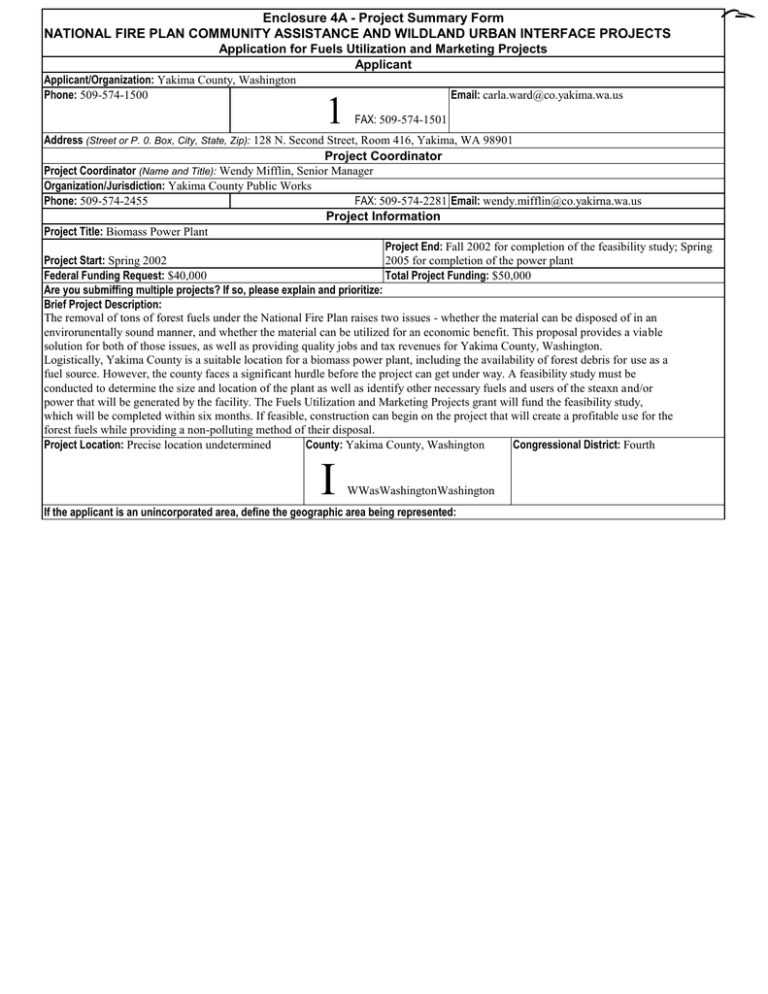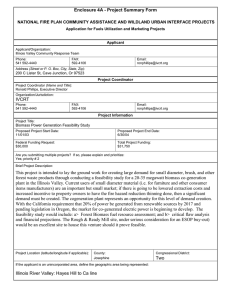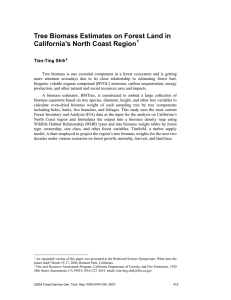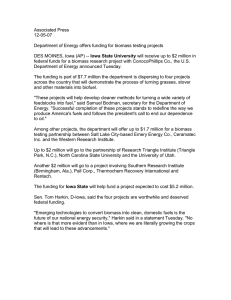Enclosure 4A - Project Summary Form
advertisement

Enclosure 4A - Project Summary Form NATIONAL FIRE PLAN COMMUNITY ASSISTANCE AND WILDLAND URBAN INTERFACE PROJECTS Application for Fuels Utilization and Marketing Projects Applicant Applicant/Organization: Yakima County, Washington Phone: 509-574-1500 Email: carla.ward@co.yakima.wa.us 1 FAX: 509-574-1501 Address (Street or P. 0. Box, City, State, Zip): 128 N. Second Street, Room 416, Yakima, WA 98901 Project Coordinator Project Coordinator (Name and Title): Wendy Mifflin, Senior Manager Organization/Jurisdiction: Yakima County Public Works Phone: 509-574-2455 FAX: 509-574-2281 Email: wendy.mifflin@co.yakirna.wa.us Project Information Project Title: Biomass Power Plant Project End: Fall 2002 for completion of the feasibility study; Spring Project Start: Spring 2002 2005 for completion of the power plant Federal Funding Request: $40,000 Total Project Funding: $50,000 Are you submiffing multiple projects? If so, please explain and prioritize: Brief Project Description: The removal of tons of forest fuels under the National Fire Plan raises two issues - whether the material can be disposed of in an envirorunentally sound manner, and whether the material can be utilized for an economic benefit. This proposal provides a viable solution for both of those issues, as well as providing quality jobs and tax revenues for Yakima County, Washington. Logistically, Yakima County is a suitable location for a biomass power plant, including the availability of forest debris for use as a fuel source. However, the county faces a significant hurdle before the project can get under way. A feasibility study must be conducted to determine the size and location of the plant as well as identify other necessary fuels and users of the steaxn and/or power that will be generated by the facility. The Fuels Utilization and Marketing Projects grant will fund the feasibility study, which will be completed within six months. If feasible, construction can begin on the project that will create a profitable use for the forest fuels while providing a non-polluting method of their disposal. Project Location: Precise location undetermined County: Yakima County, Washington Congressional District: Fourth I WWasWashingtonWashington If the applicant is an unincorporated area, define the geographic area being represented: • A site recommendation. Cost the studyIisof $50,000, of which the grant will provide $40,000. Costs of the study will Enclosure 4Bof (Page 3) - Project Narrative Description include plant drawings (20 percent), forest ftiel availability (10 percent), plant process calculations (10 percent), administrative (10 Applications for funding must include a narrative (10 response that describes the proposal. do not submit responses longer one page, percent), combustion efficiency and emissions percent), power/steam potential Please (10 percent), local administration (10than percent), pro forma (5 percent), plant location (5 percent), necessity of alternative ftiels (5 percent), and infrastructure needs (5 percent). single space, 12-pitch font. Describe project including, but not limited to: Address these 0 0 project 2. The development of a project biomasslocation power plant typically takes from twoincome to three years for a five- to ten-megawatt plant. The first year would be dedicated to securing: items as 0 project implementation * project time frames • Fuel and power or steam contracts applicable: 0 specify types of activities and equipment used • A construction0 siteanticipated outcomes • Air quality, building and zoning permits 0 measures and reporting 9 amount or extent of actions (acres, number of homes, etc) • Funding. An Environmental Impact Statement also may be required. Actual construction and startup activities should take about 0 partners * environmental, cultural one year to eighteen months to complete. A five-megawatt plant usually occupies aboutand 20 historical acres andresource employs requirements about 25 people. Response: The scope of the project is actually twofold. The grant will help fund a feasibility study, which will lead to the construction of a biomass power plant. 1. The thrust of this grant is to study the feasibility of locating a biomass plant in Yakima County. Energy Products of Idaho (EPI) or another independent contractor will conduct the study within six months for the county. It will include the basic elements for a biomass plant. First is the fuel availability on a continuing basis, and second is the sale of steatn and/or generated electricity on a contractual arrangement to an appropriate utility or consumer. Additionally, the feasibility study will include the following items as outlined in an RFP: • A review and documentation of the current studies in process and completed relating to forest fuels available; • A Gatmt chart listing required tasks and persons responsible for such tasks, the costs for each task and an estimated date for task completion; • A pro forma financial statement, including an economic analysis, outlining the anticipated costs and income factors based upon the recommended biomass plant size. • A biomass plant size recommendation based upon fuel availability, continuity of fuels, and contractual electrical sales (megawatt production capability); • An environmental specifications report identifying the type and wnount of pollutants the proposed plant may create by technologies evaluated; • A report on the infrastructure needs, such as water, of the proposed plant; Enclosure 4B (Page 2 of 3) - Project Evaluation Criteria Applications for ftinding must include narrative responses that address the following four criteria. Within each criterion, subcriteria are listed in descending order of importance. Limit your responses to the areas provided. 1. Increasing Local Capacity (35 Points) A. How would the proposal improve or lead to the improvement of the local economy in terms ofjobs and sustainable economic activity? How many jobs are expected to be created or retained and for how long (please distinguish between essentially year-round and seasonal jobs)? B. Will biomass or forest ftiels be utilized; if so, in what manner and how much? C. Which, if any, private businesses will participate? D. To what extent will this project be offered to serve as a model for other communities or businesses? Response: A. A five-megawatt biomass power plant will create about 25 permanent, year-round positions at the plant site. Additionally, the plant would generate an undetermined number of other local jobs related to the harvesting forest fuels and transporting them to the facility. B. Forest fuels will be used at the approximate rate of 150 tons per day. Other biomass fuels also could be utilized including municipal solid waste, animal waste, agricultural and industrial waste and sewage and paper sludge. C. The contractor, as selected through the RFP process, will conduct the feasibility study. If the project is feasible, the selected contractor will design and construct the plant with the help of subcontractors. Other private contractors will be involved in the collection and transportation of forest and other ftiels to the plant. D. The project will serve as a model in two capacities: I . Biomass technology is exceptionally clean in terms of emissions, and can combust a much wider range of fiiels, which allows the owner/operator to compensate if one fuel source diminishes. This technology is not widely known by municipalities, which could benefit from its use. 2. Developers of the project will help the Forest Service establish a viable method of collecting forest ftiels and transporting them to the site of the power plant. These harvesting methods can be employed by other projects. 2. Reducing fire risl (30 points) Describe how the proposal promotes reduction of risk in high hazard areas and communities. Describe how the proposed project benefits resources on federal land or adjacent non-federal land, or how it protects the safety of communities. C. To what extent does the project implement or create a cooperative fuels treatment plan or community fire strategy (include evidence of the plan if it already exists)? D. Explain how the proposal (a) leads to, enhances or restores a local fire-adapted ecosystem, and/or (b) mitigates or leads to the mitigation of hazardous fuels conditions. Response: A. The project will provide a permanent, non-polluting means of utilizing forest fuels that are adjacent to populated areas. The forest fuel will be used to produce power, which is a direct benefit to the respective communities and a motivation to remove the materials on a continual basis. B. Thinning ladder fuels not only reduces fire danger, but also enhances the health of the forest. However, not all of the ladder ftiels have an economic benefit. Finding a use for slash and other small-diatneter material could be difficult in the absence of a biomass power plant. C. A guaranteed method of disposing of otherwise useless forest waste will help foster a cooperative fuels treatment plan or community fire strategy. D. Providing a profitable use for forest fuels will provide the impetus to maintain a mitigation of hazardous conditions. A. B. Social - The project Enclosure will provide numerous 4B (Page well-paying 3 of 3) jobs - Project to the community Evaluation as well as Criteria a reliable, environmentally friendly Response: B. Increasing source ofinteragency power. Tax revenues and intergovernmental from the plant will coordination. help fund the (15community Points) infrastructure and social programs. Educational - The project will provide a tangible example of how biomass technology can convert waste into energy without hartning the environment. Public awareness of the benefits of green power has become a priority of the government, and Yakima County will be a case in point. A. To what extent have interested people and communities been provided an opportunity to become informed and involved in this proposal? B. Describe the extent of local support for the project, including any cost-sharing arrangements C. What are the environmental, social and educational benefits of the project? A. The Yakima County Board of Commissioners and Public Works Department and the Yakima County Development Association are informed, involved and supportive of the project. B. The level of local support is high. The county commission unanimously has endorsed the proposal, and the Yakima County Development Association is assisting in the grant application process. Yakima County is providing $2,000 cash of the local match and assuming the responsibility for the match balance. C. Envirorunental - In addition to reducing wildfires and improving the health of the forest by utilizing ladder fuels, the project will provide a non-polluting method of disposing of the debris. Biomass technology has proven to be the cleanest combustion method in the industry. The alternatives would be natural decomposition, open burning, or landfilling, none of which are enviroriimentally friendly methods of disposal. 4. Increasing interagency and intergovernmental coordination. (20 Points) A. Explain the level of cooperation, coordination or strategic planning among federal, state, tribal, local government and community organizations in developing this proposal. List the cooperators. B. Describe how this project implements a local intergovernmental strategy or plan, or creates such a plan. Describe the plan if A. Partners in the project include the Yakima County Board of Commissioners and the Yakima County Development Association B. The afore-mentioned entities as well as various Yakima County agencies have been aggressively working on an economic development strategy that will bring jobs to the community. Job creation through a biomass power plant project will have a multiple effect. 2. Ancillary jobs will be created through the removal of forest ftiels as well as the transportation of materials in the various operations related to the biomass plant. 3. Administrative jobs will be created to monitor and manage entire systems ranging from fuels location and extraction to ash disposal to power sales and transfers. 4. There will also be a significant boost to the local economy through a dramatically increased tax base and the flow of new dollars to circulate within the community. it already exists. Response: I . Jobs will be created at the biomass plant site for operation and maintenance. Enclosure 4C - Project Work Form Tasks Time Frame Responsible Party Conduct a feasibility study to determine the size and location of a biomass power plant in Yakima County as well as identify other necessary fuels and users of the steam and/or power that will be generated by the facility. Six months. Independent contractor selected through the RFP process. Design and construct a biomass power plant in Yakima County. Three years maximum. Contractor. Agency Applicant Partner I Budget Enclosure 4D -Project Partner 2 Total Cost Category Description Federal Personnel - ------------ - Fringe Benefits ---- - - - - - ----------- - ---- - ------ Subtotal Travel Subtotal ----------------------------------------- I Equipment ------------------------------------------------------------------------------------- Subtotal --------------------- Supplies Subtotal ----------------------------------------- Contractual ----------------------------------------------------------------------------------------------------------- Subtotal Other Subtotal ------------------------------------------ Total Costs $40,000 ------------------------------------------ ------------ $10 ----------------------,00 -----0 --------------------- $50,000 Project (Program) Income' Program income is the gross revenue generated by a grant or cooperative agreement supported activity during the life of the grant. Program income can be made by recipients from fees charged for conference or workshop attendance, from rental fees earned from renting out real property or equipment acquired with grant or cooperative agreement funds, or from the sale of commodities or items developed under the grant or cooperative agreement. The use of Program Income during the project period may require prior approval by the granting agency. 1



